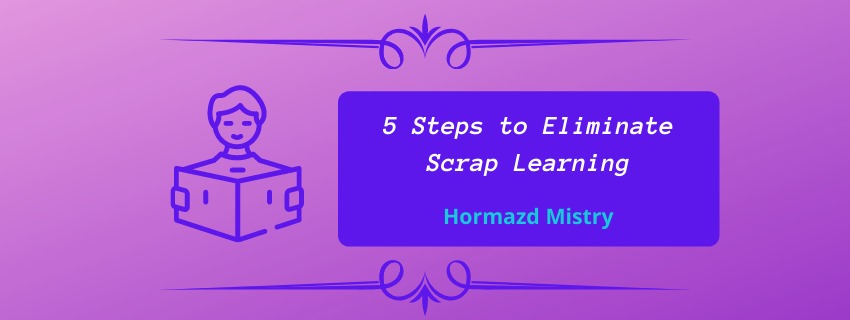
Five Steps to Eliminate Scrap Learning
Hormazd Mistry
(2021-02-28)
Everyone is focusing on gaining new skills, and even organizations want to ensure that their employees stay occupied, if not with remote work, then with virtual learning programs.
The biggest challenge that Learning Professionals face today is curating relevant content for learners. Content that eventually results in a positive business impact. To make matters worse, participants often complete their learning modules but fail to apply the learnings, which results in the gained knowledge/skill getting wasted. And this is called Scrap Learning.
Scrap Learning, usually represented as a percentage, is the amount of learning a learner has gained but does not apply on the job. It showcases the wastage in training time and money. When we look at the learning evaluation levels (Fig. 1), scrap learning is the fallout from achieving Level Two - Learning (attaining defined knowledge/skills) but not achieving Level Three - Application (application of gained knowledge/skill to the job).

Fig. 1 – Five Levels of Learning Evaluation as per ROI Methodology®
The higher the Scrap Learning, the lower is the perceived value of learning interventions. To drive the maximum business impact from learning interventions, Scrap Learning needs to be at a minimum.
There are Five Steps that Talent Development Teams can take to eliminate scrap and make their learning programs relevant.
- Start with WHY: The first step to removing Scrap Learning is identifying the program's need in alignment with the business outcomes. Learning Professionals need to know what changes in behavior, performance, skill, knowledge, or attitude the learners need to demonstrate after completing the program and how will the business outcomes improve. Learning professionals need to change their questions from "What training is required?" to "Why is this training required? What business measure are we trying to improve?".
- Define SMART Objectives for all Levels: Learning professionals are champions at creating SMART Learning Objectives. What they miss out on is creating objectives for the other program levels. Learning professionals must start creating SMART Objectives for all program levels. It provides a razor-sharp focus in identifying the program's components and prevents any scrap elements from sneaking in. It also creates a roadmap that helps everyone understand the program's learnings and benefits from its application/implementation.
- Get Managers Involved: Learning Teams need to get participant’s managers involved in the process. They should communicate to the managers the program's goals and how they are enablers to the program's learning implementation. Fig. 2. showcases a sample template of the Learning Transfer Strategy that provides details on actions that various role-players need to take at each phase of the process. It helps them understand their role, making them accountable for their part of the process. Fig. 2. Learning Transfer Strategy Template
 Fig. 2. Learning Transfer Strategy Template
Fig. 2. Learning Transfer Strategy Template - Choosing the Right Solution: Learner preferences have evolved. 70-80% of learning now occurs on the job. Learners prefer to learn at the point of need more than making it a one-off activity. The right solution will have to be a blend of approaches that provide learners with various learning avenues. Learning teams need to create a continuous learning strategy that reinforces learning while complementing the implementation process.
- Evaluate, Evaluate, Evaluate: As the learning journey progresses, learning teams should collect the program's outcome data at each level. Comparing the outcome data with the SMART Objectives for that level will tell about the program's success. It will also indicate whether the participants are applying the knowledge/skills gained from the program or not. If the evaluation identifies any barriers to implementing the learnings, then efforts need to be made to remove those barriers. If some scrap learning still exists, use the findings to revise the program design and eliminate it.